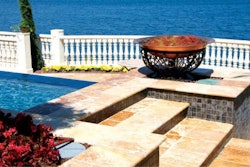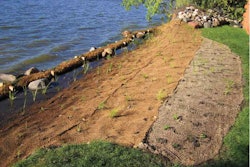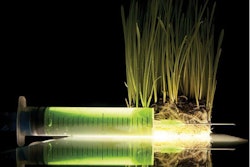Color Schemes
How to plan to extend blooms year-round
A landscape that peaks in spring is a common theme in many residential areas. Instead of being the pinnacle, though, spring should signal only the beginning of things to come, setting the pace for summer and fall.
Plumbago“Chart out the seasons and make sure you have a favorite perennial blooming in each stage,” says Alan Branhagen, director of horticulture for Powell Gardens, Kansas City’s botanical garden. He recommends putting together a plan that starts with evergreen foundation plants and perennials and mixes in annuals to add interest in-between, extending blooms from one season to the next.
A little green
Dwarf conifers are a good choice for any landscape because they provide year-round color and are easy to maintain. Choose from bluish greens to dark greens or even golds. “Whatever your color scheme, there is a dwarf conifer that will fit it,” Branhagen says. “There is an amazing array available. They may cost a little more up front, but they are worth it in the long run.”
Design tip: He says the “old sheared look” of evergreens is out (think large, elaborately shaped evergreen). “They were just too difficult to maintain,” he says. So be sure to stay away from these when planning.
Also in the category of evergreen are boxwoods. Branhagen recommends these plants to give landscapes a good all-season structure. “There are varieties to fit any need,” he says, “and they are hardy and dense plants” that provide a good backdrop for your perennial bloomers.
Graceful grasses
Drought-tolerant and hardy, ornamental grasses are what Branhagen calls a “no-brainer.” Not only are they low-maintenance plants that add color to the landscape, but they also add texture and movement. He especially likes Miscanthus grasses that hold their color into the winter, switch grasses for their purple and red coloring and fountain grasses.
Chart out the seasons and make sure you have a favorite perennial blooming in each stage.
Popping perennials
To get the most from your landscape, Branhagen suggests including long-blooming perennials that will be true workhorses, keeping their color for much of the season.
photo courtesy of Powell Gardens
• Moonbeam Coreopsis features light yellow blooms that will give color through thick and thin.
• Walker’s Low Catmint offers soft blue flowers with grayish-green foliage and blooms late April through November with one shearing.
• Happy Returns daylily boasts bright yellow flowers that keep coming back all season long.
• Russian sage combines showy foliage and blue flowers that bloom midsummer through the fall.
The key to a successful all-season landscape is learning to combine plants with complementary and contrasting growing seasons so the landscape never looks empty. For example, combine Plumbago (a short perennial also used as a groundcover) with colchicums (a fall-blooming bulb) for a complementary balance. “Plumbago is one of the most underutilized groundcovers,” Branhagen says. “It’s versatile, tolerates sun or light shade and blooms midsummer to fall with blue flowers and burgundy (in fall) foliage.”
Annual Additions
“There is no single annual that is really going to get you through summer,” Branhagen says, “but they are great season extenders.” Use them for color around perennials, as fillers and to add a bit of color. “Plant perennials and groundcovers first and tuck bulbs in-between. Then use annuals to fill in the gaps.” You can also plant annuals on top of and around dormant bulbs to disguise wilted foliage.
Color Cue
When it comes to choosing landscape colors, Branhagen says house color and your client’s personal taste should be your guide. Some popular combinations are silver and gold flowerbeds or ones that combine soft blues and yellows.
There is no single annual that is really going to get you through summer, but they are great season extenders.
“Pastels are passé, but they are the perfect choice for some more conservative clients,” Branhagen says. “If you’re looking for something a little less traditional, try putting together a landscape bed of scarlet and blues.
“Orange is really gaining in popularity, too, so a bed that features oranges in combination with pinks and burgundies is going to provide a really nice contrast that looks current.”
Test of time
There are bulbs that bloom early, mid- or late-season, so be sure to read the bulb’s label to ensure that it will bloom when you want. Or plant them all together to extend the season. m
Selling Points
Having trouble talking your client into boosting color in flowerbeds in front of their home? Remind them about the impact landscaping has on property value and the overall outsider perception of their home.
First impressions are everything. If the outside of a home doesn’t look good, it implies that the inside won’t be much better. Kiplingers.com reports spending even $400 on plants to beef up landscaping can result in an increase in $1,500 to $2,000 in added home value.











